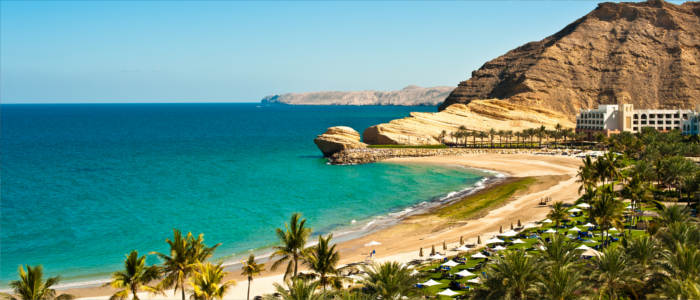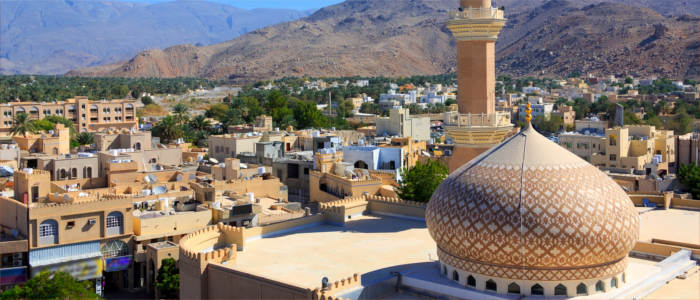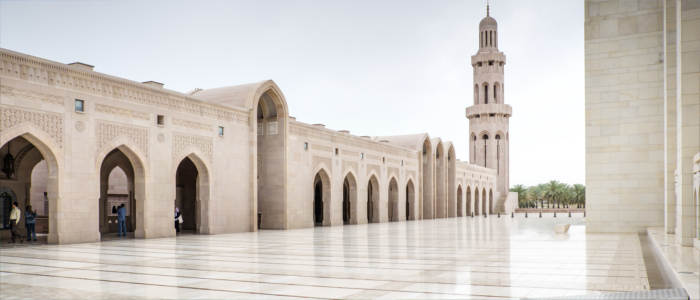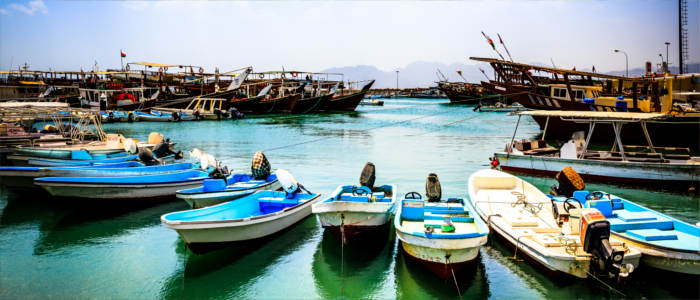Travel Offers
Travelmyne Featureprint
Distance
Oman - The Sultanate of the Maritime Nation
Adventure is in the air when travellers set off to Oman. The tradition of the ancient sailors unites with the oriental magic of the Bedouin in the Sultanate of Oman in the East of the Arabian Peninsula.

Geography - The heat of the Sultanate
The Sultanate of Oman lies in the very east of the Arabian Peninsula and borders on the United Arab Emirates, Saudi-Arabia and Yemen. The Arabian Sea and the Gulf of Oman constitute natural borders. As the country is located in the range of the monsoon, it is mainly dominated by tropical climate. However, it is very hot and dry in the heartland and 40 to 50 °C in the desert regions. The coastal areas are not as hot but they have extremely high humidity. The average temperature is around 35 °C and quite exhausting for travellers who are not used to such hot and humid weather.

Nature - Deserts and beaches
Although Oman is a typical desert state, the country contains a great variety of landscapes. Besides the desert Jiddat al-Harasis and the great sandy desert Rub' al Khali, visitors are fascinated by the deep gorges of the wadis, the mountainous landscapes of the Hajar Mountains and the fertile oases. The highest mountain is Jebel Shams with a height of 3,009 metres. In addition, the country has several very attractive beaches and cliff coasts. The beach in Yiti and the lagoons in Dhofar, for example, are worth seeing. In front of the coast you find wonderful coral reefs with over 100 different types of corals. Green date trees and frankincense brave the heat on shore. With a bit of luck, visitors can watch Arabian leopards, oryxes and turtles as well as dolphins in the sea.

Natural sights - Dunes and oases
Oman offers a number of impressive attractions. Examples are the fjord landscape in Musandam, the Wadi Bani Khalid and the dunes in the Wahiba Sands. The Hajar Mountains are also worth a visit. Travellers find refreshment in the country's green oases or in the karst cave Al Hoota Cave.

Culture - The combination of tradition and modernity
The Omani nation looks back on a 5,000-year-old maritime tradition and maintains this heritage as part of their culture. The Omanis have a special position in the Arab world. They pride themselves on placing value on the equality of men and women. This means that women are allowed to do almost every job, even on a higher administrative level. Furthermore, they do not have to wear head scarves and there is no strict dress code. Considerably more women are enrolled at university nowadays, so that a male quota had to be introduced. All Omanis have the right to vote as soon as they reach the age of 21. The Sultanate adheres to the constitution from 1996 and propagates tolerance and non-violence. These are also seen as the main values of the Islam, which is the most common religion in Oman. Besides mosques, you also see Christian churches and several Hindu temples in the country. The Omanis are considered friendly, calm and open. They maintain their tradition but they do not close their minds to the spirit of modernity.

Cultural sights - Fortresses and frankincense trade
Bahla Fort, the archaeological site of Bat, the necropolis of Al-Ayn with its 4,000-year-old beehive tombs as well as the frankincense and the sites of its trade were declared World Cultural Heritage sites by the UNESCO. The country's fortresses are among the most popular destinations. Nakhal Fort, the hidden alleys of Al-Hazm Fort and the Jabrin Palace are part of most guided sightseeing tours. The maritime history of the Omanis comes alive again in the seaport city of Sur and the frankincense harbour in Samhuram is another World Cultural Heritage site. Other destinations are the ruins of mud-walled houses in al-Minzafa and the old town wall of Manah.

Experience - Arab delicacies
The heritage of the sailors can still be felt in Oman's cuisine. Influences from China, India and Saudi Arabia have long been part of the local specialities. The most common side is rice, which is served with dishes like chicken saloona (baked chicken in tomatoes and garlic) or maqbuus (lamb with dried limes). Freshly bakes types of bread such as naan, paratha and chapati round off the meal. The inhabitants often end their meal with strong coffee drunk from small china cups. Alcohol is only served in hotels or in private rooms in clubs. Drinking alcohol in public is prohibited. Characteristic Omani shopping facilities are the souqs (markets). You find the most beautiful and greatest ones in the capital and in Nizwa. Valuable fabrics, decorative lamps made of gold and silver, jewellery, the Omani janbiya and frankincense are popular souvenirs.

Activities - The call of the sailors and Bedouins
The Oman is not a typical destination for holidays at the seaside but it is possible to go bathing here. You find beautiful beaches near the capital and in Dhofar. However, instead of bikinis holidaymakers should pack longer bathing shorts and suits. There are several diving schools near Muscat and the most beautiful diving spots take travellers to remote reefs and sunken shipwrecks. Some operators even offer diving safaris. Visitors of the desert state are generally fascinated by the country's waters . They can enjoy the country's beauty on trips with a sailing boat, small motor boats or traditional dhows. Starting points are Oman's seaport cities. The country's heartland is relatively well developed too. Over 40 trekking paths lead into the mountains to the wadis or oases and hikes along the coast are possible as well. Advanced mountaineers can try climbing the south-east wall of the Jebel Mischt, which is 1,000 metres high. Visitors should also follow the call of the Bedouins and set off into the desert by Jeep. The company of a Bedouin guide and a lot of drinking water constitute the basic equipment for the survival in the Wahiba Sands.

Information
The best way of arriving in Oman is by plane. Most international airlines travel via Dubai. In winter, the temperatures are considerably more pleasant than in the summer months.
The desert country of Oman is characterised by tradition and modernity and combines both in its culture. Relaxation at the beaches and exciting activities both on the water and on shore make Oman an interesting travel destination.




















